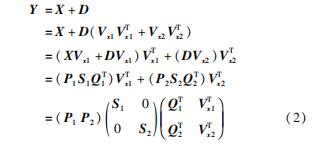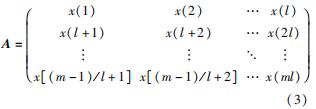基金项目: 国家液体火箭发动机重点实验室基金(6142704220401, 6142704210403, 6142704220403)
作者简介:王得龙(2000—),男,硕士,研究领域为液体火箭发动机故障诊断及健康管理。
1. 西北工业大学 动力与能源学院,陕西 西安 710129; 2. 西安航天动力研究所,陕西 西安 710100
1. School of Power and Energy, Northwestern Polytechnical University, Xi'an 710129, China; 2.Xi'an Institute of Aerospace Propulsion, Xi'an 710100, China
turbopump; rolling bearing; envelope spectrum; singular value decomposition; fault diagnosis
DOI: 10.3969/j.issn.1672-9374.2024.01.015
降低火箭成本一直以来都是一个重大的难题。作为降低航天发射成本的重要途径之一, 重复使用发动机是未来火箭发动机的重要发展方向之一[1]。美国SpaceX公司研制的猎鹰9号火箭首次完成第一级火箭回收,引起世界各国对火箭重复使用技术的高度关注[2]。重复使用后,对火箭涡轮泵轴承的减损控制提出了更高的要求,而且由于轴承运行速度极快,工作在高温、高压和强振动等恶劣环境中,容易发生故障[3]。因此能够准确地对轴承进行故障特征提取从而实现故障诊断尤为重要[4]。
针对滚动轴承故障特征信号提取其中轴承故障特征频率的过程被称为故障特征提取[5]。该过程是滚动轴承状态检测和故障诊断的前提条件,对轴承故障识别的精确度和状态预示的准确性有着重要的影响[6]。同时,特征提取也是目前轴承故障诊断研究领域的热门话题之一。
由于时域信号的局限性,快速傅里叶算法得以发展,人们得以从频率的角度入手对信号展开分析,并以此为根据开发了频谱分析仪。冲击脉冲仪(Shock Pulse Meter, SPM)以此为基础发展而来,它是一种用来记录冲击激励的仪器[7]。
在硬件之后开始大量出现的是一些数据计算方法,比如倒频谱分析[8]、共振解调技术[9]等方法用于提取边频信号。根据复杂现实工况的要求,在傅里叶变换频谱分析进行的故障诊断之后,已经逐渐发展出各种不同的信号处理方法。比如短时傅里叶变换(Short Time Fourier Transform,STFT),是一种时频分析的方法,是傅里叶变换的推广,可以克服傅里叶变换计算工作量大、计算时间长等缺点[10]。小波变换[11-13]、自适应信号时频处理方法-经验模态分解(Empirical Mode Decomposition, EMD)法[14-15]、奇异值分解(Singular Value Decomposition,SVD)方法[16-17]、随机共振(Stochastic Resonance,SR)[18-19]方法等技术适用于非平稳信号的分析; 盲源分离(Blind Source Separation, BSS)是指在原始信号和传递通道参数都未知的情况下,通过观测信号来恢复源信号的一种方法[20]。
以上方法都是通过调整硬件或者直接对测得的数据进行计算处理来获得更为准确的特征频率。并且大多数方法仅适用于一些特定的情况,适用范围较小。目前包络谱解调法是最为稳定且适用范围最大的一种方法,但是包络谱解调法的效果受噪声影响较大,对较为复杂环境中测得的数据处理效果较差。因此本文在包络谱解调法的基础上提出对信号进行预处理的方法。利用奇异值分解对测得数据先进行重构再进行故障特征提取,以此来减小噪声的影响,提高故障特征提取的精度。
基于奇异值分解的降噪技术是一种子空间算法。其原理是将含噪声信号的向量空间分解为两个信号子空间,一个是由纯净信号主导,而另一个是由噪声信号主导,然后将落在“噪声空间”中的含噪声信号向量分量去除,以此达到估计纯净信号的目的。将含噪声信号向量空间分解为 “噪声子空间”和“信号子空间”,可以采用正交矩阵分解技术,即奇异值分解。
假设矩阵Y为包含纯净信号数据的矩阵,D包含噪声数据。目的是从给定的含噪声信号矩阵Y恢复出X中包含的信号。这等效于通过奇异值分解从中恢复信号子空间,因此给出奇异值分解,即

式中:Ux1为N×r矩阵; Ux2为N×(N-r)矩阵; Mx1为r×r矩阵; Vx1为r×m矩阵; Vx2为(N-r)×m矩阵。
Ux1张成的空间为X的列空间,称为信号子空间。利用矩阵Vx1和Vx2及酉矩阵性质,可以将含噪声信号矩阵Y写为

式中:P1S1QT1和P2S2QT2分别为上一行公式括号中的矩阵的奇异值分解。
若PT1P2=0,则式(2)为有效的奇异值分解。但由于P1≠Ux1,所以X的信号子空间无法恢复。因此,对于含噪声信号Y,给出了通过计算奇异值谱来恢复信号矩阵X的方法,详细步骤如下。
首先对于一维的采样信号进行等间隔采样,按每行l个采样点可得到一个m×l的矩阵A,即

然后对矩阵A进行奇异值分解,得到

其中Mk由非零奇异值组成,即

通常σ1/σ2被定义为矩阵的主奇异值比,保持主奇异值不变,将其余奇异值取0后得到新的矩阵,最后将多维矩阵进行一维化处理就可以得到处理过的降噪信号Ar。
使用简单的正弦信号的叠加[即y=10sin(t)+2cos(2t)]对奇异值比谱法在轴承信号重构应用中的可行性进行验证。
简单正弦信号奇异值分解处理如图1所示,纵坐标为无量纲幅值。通过图1中的对比可以比较直观地看出经过奇异值分解处理后信号变得平滑,在图形上也更接近于原始信号。通过计算可以得到3种信号的特征参数,如表1所示。
通过表1中计算得出的特征参数可以看出,奇异值分解后的信号虽然在峰值上受噪声的一定影响,但是一些与峰值无关的特征参数几乎与原始信号相等,奇异值分解重构信号效果良好。当火箭涡轮泵轴承故障时,产生的振动信号具有准周期的性质,正是利用这一特性奇异值分解才可以实现周期信号的探测。
信号解调是信号调制的逆过程,是从已调制的高频信号中解调出原调制信号。信号调制包括调幅、调频、调相,因此信号解调的目的是根据已有信号,提取出信号的包络、相位、频率信息。
包络谱解调是一种信号处理技术,其原理是将带调制的信号转化成其振幅的包络信号。它的基本思路是首先对带有调制的实测信号进行希尔伯特变换,在得到包络信号后,对信号进行解调处理。包络谱解调的原理如图2所示。
希尔伯特变换是广泛用于数字信号处理中的一种时域卷积方法,设x(t)为连续信号,其希尔伯特变换为

式中h(t)=1/(πt)。
对式(7)进行傅里叶变换可得

根据卷积定理和式(8),独立频率分量可以通过希尔伯特变换,在保持幅值不变的情况下,使相位发生90°偏转。同时,希尔伯特变换具有如下性质。
H[X(fa)Y(fb)]=X(fa)H[Y(fa)] fa<fb (9)
对低频信号与高频信号乘积进行希尔伯特变换后,低频信号不变,高频信号进行一次希尔伯特变换。由此可以推导出,若对两个信号的乘积进行希尔伯特变换,高频信号相位会偏转90°。因此可以构造如下解析函数用以验证希尔伯特变换的效果。

因为只有高频信号发生偏转,所以可以利用三角函数性质,使用平方和计算消除高频信号,得到低频信号成分即包络信号[见式(11)],再将包络信号转换成频域信号。

将函数y1=1+sin(50t)+cos(20πt)作为原始信号,函数y2=cos(30πt)+cos(200πt)作为载波信号,对两个信号进行y=y1y2的调制。
在频域图中可以看到很多边频带,说明该信号经过调制后,很难区分出25 Hz和10 Hz的频率。再对信号进行包络谱解调,结果如图5所示。
从图5的对比中可以看出,包络谱解调后的频域图中10 Hz和25 Hz的频率相比于原来的频域图更加明显。这说明包络谱解调能够比较准确地提取出信号中的包络信息,去除掉高频成分,保留有用的低频信息。但是在有较多干扰成分和高频噪声的情况下,包络谱解调的效果会大大降低,因此需要在原有的基础上对包络谱解调进行改进,本文采用对数据进行重构的方法来减小噪声的影响。
为了更加贴合实际,仿真以N1006轴承为基准,其结构参数如表2所示。
故障类型及相应的故障特征频率计算式如表3所示。其中Z为滚动体数目,d为内环直径,D为外环直径,θ为接触角角度,fr为旋转基频。
滚动轴承冲击信号模型为

式中:i为第几次冲击; Ai为冲击的总数目; T为冲击信号的周期; τi为第i次冲击相对于周期T的滑移; n(t)为噪声信号; fn为轴承固有频率; Φw为共振函数的初始相位; fr为轴承部件的转动频率; B为衰减系数,决定了冲击信号的衰减速度。
对N1006型轴承利用2.1节的冲击信号模型对外环、内环及滚动体的单点故障进行数据仿真,其结构参数如表2所示,仿真结果如图8所示。其转速为900 r/min,根据表3中的公式可以计算得出故障特征频率分别为97.6、133.66、100.9 Hz。加入噪声后先进行传统包络谱解调提取故障特征,然后再用奇异值-包络谱解调法进行处理。
从仿真信号的传统包络谱解调频域图和奇异值-包络谱解调频域图的对比中可以发现,改进方法处理后的数据图像相较于传统方法从低频区上来看,转频、基频和低倍频的幅值均有所增加,而且在高频区仍可看到比较清晰的故障特征频率高倍频。计算处理后可得信号的信噪比如表4所示。通过计算发现改进方法处理后的数据信噪比提高了约60 dB。
设计建造如图9所示的转子-轴承-承力框架实验器。该系统由三相异步电机驱动转轴,并且可以通过手动调节变频器来改变转轴转速。
转轴中央设有一个带有螺纹孔的盘,可以通过在螺纹孔中旋入螺钉来改变转轴的不平衡量。该转轴的两端使用的是不同的轴承设计:靠近电机端的轴承使用球轴承内圈过盈配合,没有故障作为标准参考; 远离电机端的轴承使用滚动轴承内圈过盈配合,模拟故障状态。这两个轴承的外圈固定在轴承座上,这样在实验时可以模拟轴承外圈不动但内圈转动的情况。
在该系统中,振动信号的测量是通过在轴承座上攻入螺纹孔,在水平和垂直方向上布置加速度传感器来实现的。滚动轴承保持架转速的测量,则是通过在保持架上贴上反光纸,并使用光电传感器来实现的。转轴转速的测量原理和方法与保持架转速相同,但转速的大小不能直接使用变频器的值反映,因为变频器的值仅反映三相异步电机的交流电频率,并不能反映转轴的真实转速。需要使用光电传感器和反光纸来测量转轴转速。
该实验器可以模拟不同故障模式,轴承故障模式可以通过更换不同类型的故障轴承来进行模拟实验。本实验中采用外环故障轴承,如图 10所示,轴承故障信息见表5,实验转速为2 400 r/min。
对测得的加速度数据进行传统包络谱解调得到频域图并找出转频和故障特征频率后进行奇异值-包络谱解调。将得到的两类频域图放在一起对比,如图 11所示。
通过传统方法和改进方法处理出的图像对比可以发现,虽然奇异值-包络谱解调中所有频率的幅值大小都受到了一定程度的削弱,但是这种方法中特征频率的幅值相对来看更为突出。在低频区二者的处理效果相差不大,传统的包络谱解调效果甚至可能会更好一些,但是在高频区传统包络谱解调法能明显看到故障频率的高倍频和噪声及其他干扰量混在一起,无法区分。奇异值-包络谱解调法中的高频区噪声及其他干扰成分的幅值极低,依然可以比较明显地看出故障特征频率的高倍频。
处理后信号的信噪比如表6所示。通过计算发现改进方法处理后的数据信噪比提高了约70 dB。
本文以轴承单点故障引发的冲击振动信号作为研究对象,模拟轴承故障发生的环境,对故障特征提取进行了研究,提出了一种更适合于在强噪声环境下提取微弱信号故障特征的改进故障特征提取方法。通过对涡轮泵轴承在强噪声及大干扰下的信号进行处理和分析,得到以下结论。
1)相比于传统的包络谱方法,在低频信号的提取方面得到了明显的提升。并且在高频区相比传统方法可以看到较为明显的特征频率高倍频。
2)通过计算发现改进方法处理后数据的信噪比均有60 dB以上的提升。
3)该方法对火箭涡轮泵轴承在强噪声及大干扰下产生的信号进行分析和处理具有明显的效果。对保持火箭涡轮泵的结构完整性和提高其稳定性有着积极的意义。